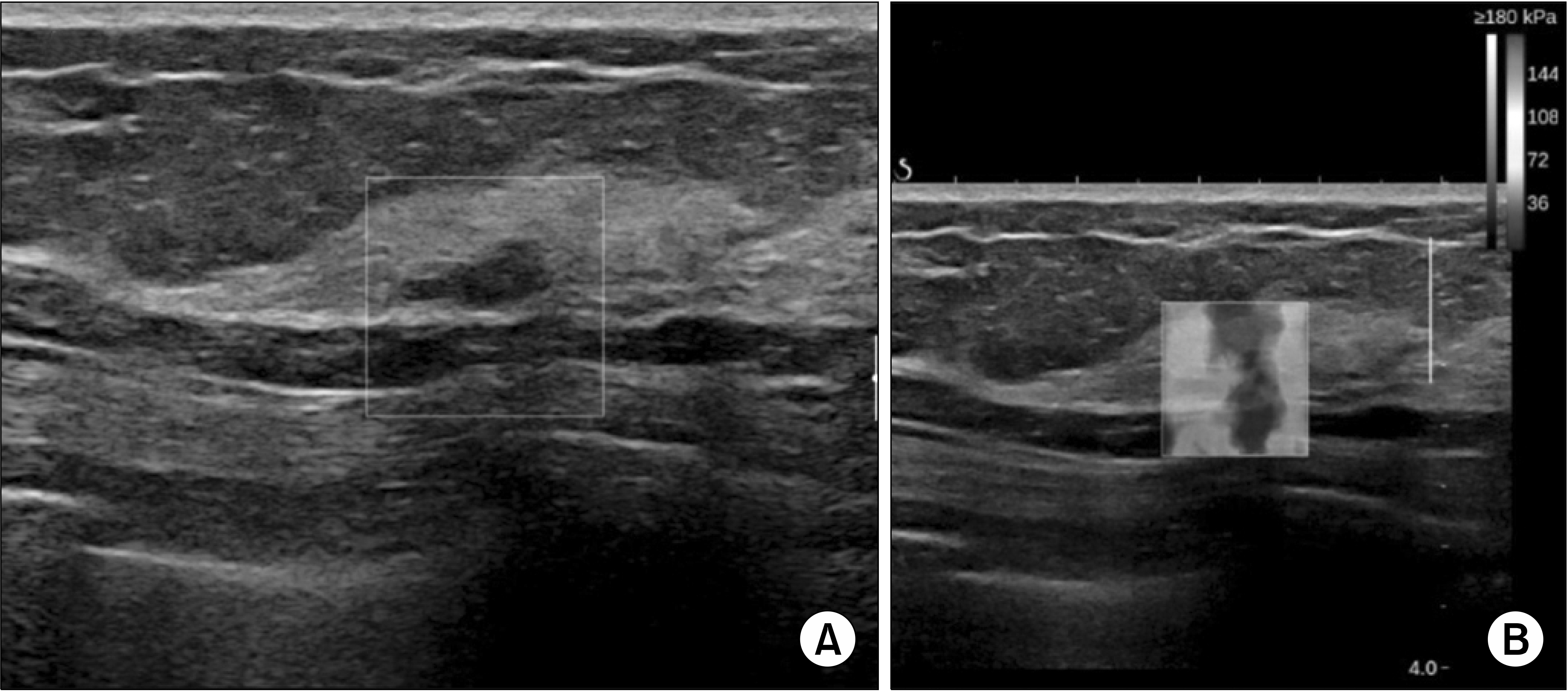J Surg Ultrasound.
2020 Nov;7(2):55-61. 10.46268/jsu.2020.7.2.55.
Predictive Value of BI-RADS Category 4A and 4B Lesions Detected on Breast Ultrasonography: Single Center Experience
- Affiliations
-
- 1Department of Surgery, Kangbuk Samsung Hospital, Sungkyunkwan University School of Medicine, Seoul, Korea
- KMID: 2511905
- DOI: http://doi.org/10.46268/jsu.2020.7.2.55
Abstract
- Purpose
The malignancy rates within the Breast Imaging Reporting and Data System (BI-RADS) category 4a and 4b lesions were examined, and the correlations with the histopathology results were analyzed. In addition, the positive predictive value (PPV) and clinical utility of BIRADS category 4a and 4b lesions for predicting a malignancy were assessed.
Methods
From January 2017 to December 2019, patients with BI-RADS category 4a and 4b lesions on breast ultrasonography (US) who underwent a subsequent core needle biopsy in the authors’ institution were evaluated. The clinical, pathological, and sonographic features were assessed to identify the malignancy rate and pathologic factors predictive of malignancy. The sensitivity, specificity, PPV, and negative predictive value (NPV) were calculated. A Binary logistic regression test was used to estimate the odds ratio (OR) and 95% confidence interval (CI).
Results
The study population included 314 lesions in 275 patients (mean age, 45.3 years; range, 21–78 years). The overall malignancy rate was 9.8% (31 of 314). The malignancy rates among the BI-RADS category 4a and 4b lesions were 9.3% (28 out of 300) and 21.4% (3 out of 14), respectively. Compared to the well-defined margins, ill-defined margins were associated with an increased risk of breast cancer with a corresponding OR (95% CI) of 1.880 (1.304-2.554). The sensitivity, specificity, PPV, and NPV of the C4a and C4b lesions were as follows: 90.3%, 3.9%, 9.4%, and 78.6%, respectively, for C4a lesions and, 9.7%, 96.1%, 21.4%, and 90.6%, respectively, for C4b lesions. Only the equivocal elasticity on ultrasonography was associated with an increased risk of breast cancer with an OR (95% CI) of 2.357 (1.004-5.532).
Conclusion
BI-RADS categories 4a and 4b are useful for predicting malignancy. Nevertheless, further studies will be needed to identify more predictive factors for breast cancer.
Figure
Reference
-
1. Ferlay J, Colombet M, Soerjomataram I, Mathers C, Parkin DM, Piñeros M, et al. 2019; Estimating the global cancer incidence and mortality in 2018: GLOBOCAN sources and methods. Int J Cancer. 144:1941–53. DOI: 10.1002/ijc.31937. PMID: 30350310.
Article2. Choi KS, Yoon M, Song SH, Suh M, Park B, Jung KW, et al. 2018; Effect of mammography screening on stage at breast cancer diagnosis: results from the Korea National Cancer Screening Program. Sci Rep. 8:8882. DOI: 10.1038/s41598-018-27152-3. PMID: 29892094. PMCID: PMC5995898.
Article3. Lee EH, Park B, Kim NS, Seo HJ, Ko KL, Min JW, et al. 2015; The Korean guideline for breast cancer screening. J Korean Med Assoc. 58:408–19. DOI: 10.5124/jkma.2015.58.5.408.
Article4. D'Orsi CJ. 2013. ACR BI-RADS Atlas: Breast Imaging Reporting and Data System. 5th ed. American College of Radiology;Reston:5. Lazarus E, Mainiero MB, Schepps B, Koelliker SL, Livingston LS. 2006; BI-RADS lexicon for US and mammography: interobserver variability and positive predictive value. Radiology. 239:385–91. DOI: 10.1148/radiol.2392042127. PMID: 16569780.
Article6. Itoh A, Ueno E, Tohno E, Kamma H, Takahashi H, Shiina T, et al. 2006; Breast disease: clinical application of US elastography for diagnosis. Radiology. 239:341–50. DOI: 10.1148/radiol.2391041676. PMID: 16484352.
Article7. Lakhani SR. 2012. WHO Classification of Tumours of the Breast. 4th ed. International Agency for Research on Cancer;Lyon:8. Yoon JH, Kim MJ, Moon HJ, Kwak JY, Kim EK. 2011; Subcatego-rization of ultrasonographic BI-RADS category 4: positive predictive value and clinical factors affecting it. Ultrasound Med Biol. 37:693–9. DOI: 10.1016/j.ultrasmedbio.2011.02.009. PMID: 21458145.
Article9. Kim EK, Ko KH, Oh KK, Kwak JY, You JK, Kim MJ, et al. 2008; Clinical application of the BI-RADS final assessment to breast sonography in conjunction with mammography. AJR Am J Roentgenol. 190:1209–15. DOI: 10.2214/AJR.07.3259. PMID: 18430833.
Article10. Elverici E, Barça AN, Aktaş H, Özsoy A, Zengin B, Çavuşoğlu M, et al. 2015; Nonpalpable BI-RADS 4 breast lesions: sonographic findings and pathology correlation. Diagn Interv Radiol. 21:189–94. DOI: 10.5152/dir.2014.14103. PMID: 25835079. PMCID: PMC4463260.
Article11. Li FS, Bai BY, Wang YM, Xiao Y, Song CX, Song ZJ, et al. 2017; Sonographic features of dense breast imaging reporting and data system 4 (BI-RADS-US4) for non-palpable breast lesions. Int J Clin Exp Med. 10:10806–12.12. Costantini M, Belli P, Lombardi R, Franceschini G, Mulè A, Bonomo L. 2006; Characterization of solid breast masses: use of the sonographic breast imaging reporting and data system lexicon. J Ultrasound Med. 25:649–59. quiz 661DOI: 10.7863/jum.2006.25.5.649. PMID: 16632790.13. Mohamed RE, Abo-Dewan KA. 2014; Incremental value of real-time ultrasound elastography in differentiating breast masses. Egypt J Radiol Nucl Med. 45:605–18. DOI: 10.1016/j.ejrnm.2014.01.006.
Article14. Ikeda K, Ogawa Y, Takii M, Sugano K, Ikeya T, Tokunaga S, et al. 2012; A role for elastography in the diagnosis of breast lesions by measuring the maximum fat lesion ratio (max-FLR) by tissue Doppler imaging. Breast Cancer. 19:71–6. DOI: 10.1007/s12282-011-0274-5. PMID: 21567172.
Article15. Crystal P, Strano SD, Shcharynski S, Koretz MJ. 2003; Using sonography to screen women with mammographically dense breasts. AJR Am J Roentgenol. 181:177–82. DOI: 10.2214/ajr.181.1.1810177. PMID: 12818853.
Article16. Lee HJ, Kim EK, Kim MJ, Youk JH, Lee JY, Kang DR, et al. 2008; Observer variability of Breast Imaging Reporting and Data System (BI-RADS) for breast ultrasound. Eur J Radiol. 65:293–8. DOI: 10.1016/j.ejrad.2007.04.008. PMID: 17531417.
Article17. Stavros AT, Rapp CL, Parker SH. 2004. Breast Ultrasound. Lippincott Williams & Wilkins;Philadelphia:
- Full Text Links
- Actions
-
Cited
- CITED
-
- Close
- Share
- Similar articles
-
- Outcomes of US BI-RADS 4A, 4B, and 4C Lesions
- Categorization and Evaluation of Usefulness of Breast Lesions with using Ultrasound BI-RADS (Breast Imaging Reporting and Data system)
- Usefulness of ultrasound elastography in reducing the number of Breast Imaging Reporting and Data System category 3 lesions on ultrasonography
- The Clinical Utility of Automated Breast Volume Scanner: A Pilot Study of 139 Cases
- Scoring System to Stratify Malignancy Risks for Mammographic Microcalcifications Based on Breast Imaging Reporting and Data System 5th Edition Descriptors



